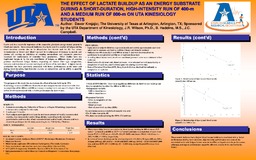
ATTENTION: The works hosted here are being migrated to a new repository that will consolidate resources, improve discoverability, and better show UTA's research impact on the global community. We will update authors as the migration progresses. Please see MavMatrix for more information.
Show simple item record
| dc.contributor.author | Krnjajic, Davor | en_US |
| dc.date.accessioned | 2011-07-08T18:27:25Z | en_US |
| dc.date.available | 2011-07-08T18:27:25Z | en_US |
| dc.date.copyright | 2011-05 | en_US |
| dc.identifier.uri | http://hdl.handle.net/10106/5620 | en_US |
| dc.description.abstract | Lactic acid is a metabolic byproduct of the anaerobic glycolysis energy system present in blood and muscle. Some research indicates that lactic acid is a marker of fatigue during short duration exercise due to its dissociation into lactate and the H+ ion, whose accumulation in tissues and blood can lead to a subsequent decrement in muscle and plasma pH causing an inhibition of coupling mechanisms and enzymatic processes necessary for maintenance of muscular force production. Other studies have not implicated lactate to be the sole contributor of fatigue, as different types of exercise produce multifaceted fatigue factors, depending on muscle fiber type composition, intensity and duration of exercise and degree of fitness of the individual. A higher lactate production has been previously associated with better performances at the onset and during short duration, high-intensity exercise or competition, and its ability to possibly offset effects of fatigue. | en_US |
| dc.description.sponsorship | Wilson, J.R. Ph.D. | en_US |
| dc.description.sponsorship | Heddins, B. | en_US |
| dc.description.sponsorship | Campbell, J.C. | en_US |
| dc.language.iso | en_US | en_US |
| dc.subject.other | Lactic acid | en_US |
| dc.subject.other | Lactate blood level | en_US |
| dc.title | The Effect of Lactate Buildup as an Energy Substrate during a Short-Duration, High-Intensity Run of 400-m and a Medium Run of 800-m on UTA Kinesiology Students | en_US |
| dc.type | Presentation | en_US |
| dc.publisher.department | Department of Kinesiology, The University of Texas at Arlington. | en_US |
| dc.publisher.department | Exercise Science Research Laboratories, The University of Texas at Arlington. | en_US |
Files in this item
- Name:
- Krnjajic.pdf
- Size:
- 859.1Kb
- Format:
- PDF
This item appears in the following Collection(s)
Show simple item record


